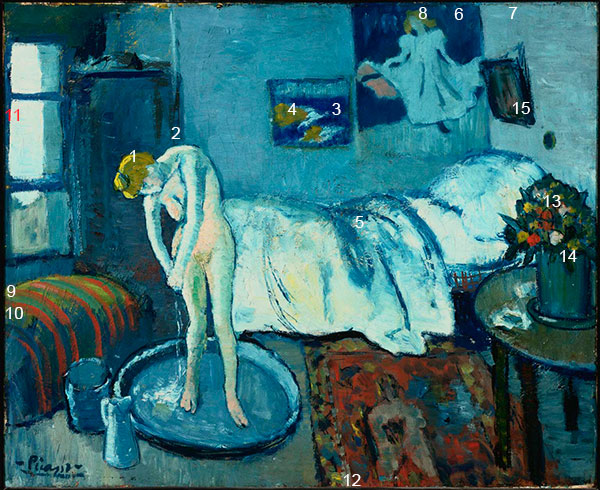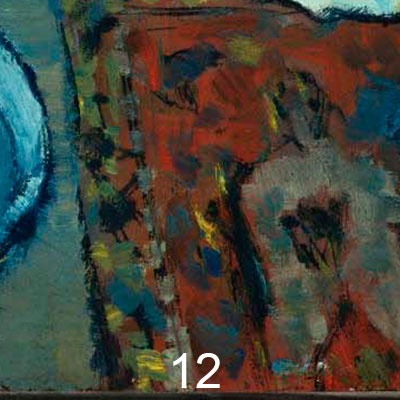Pablo Picasso, The Blue Room
1901Paintings sorted by Historical period | Painter | Subject matter | Pigments used
Hidden Portrait Beneath the Painting
The scientific investigation by Short Wave Infrared Reflectography (SWIR) revealed a hidden portrait of a well-dressed gentleman beneath the surface of the painting (1, 2).

Infrared image of Picasso’s ‘The Blue Room’
Image: Ref (1)
References
(1) Favero, P., Mass, J., Delaney, J., Woll, A., Hull, A., Dooley, K. and Finnefrock, A. (2017). Reflectance imaging spectroscopy and synchrotron radiation X-ray fluorescence mapping used in a technical study of The Blue Room by Pablo Picasso. Heritage Science, 5(1). Downloaded on 11 July 2017.
(2) Creators. (2017). How Art Experts Discovered A Hidden Portrait Beneath A Picasso Masterpiece. [Accessed 12 Jul. 2017].
Overview
Medium: Oil
Support: Canvas
Size: 50.4825 x 61.595 cm
Art Period: Blue Period
Phillips Collection Washington
Painting
Pablo Picasso, ‘The Blue Room’ is a mature work of the young artist from his Blue period. The recent scientific analysis by a variety of methods discovered a hidden portrait of a well-dressed gentleman beneath the surface of the painting. The identity of the sitter is as yet unknown.
The pigment analysis revealed a palette consisting of Prussian blue, chrome yellow, cadmium yellow, viridian, emerald green, bone black, artificial ultramarine, vermilion.
Pigments
Pigment Analysis of This Painting
This pigment analysis is based on the investigation of the painting using several methods such as Infrared Reflectance (IRR), X-Ray Fluorescence (XRF), and Reflectance Imaging Spectroscopy (RIS) described in the reference (1).

1 Yellow hair: lowest light blue layer consisting of Prussian blue, chrome yellow, cadmium yellow (?), zinc white (?), barium sulfate. A second very thin dark blue layer of Prussian blue. Top layer containing cadmium yellow, chrome yellow, Prussian blue, zinc white, and barium sulfate.
2 Dark blue area: Six different layers of paint from top to bottom:
1. Light blue – Prussian blue and zinc white with barium sulfate. 2. Green – chrome yellow, Prussian blue, copper green (possibly emerald green), barium sulfate. 3. White – zinc white with barium sulfate. 4. Red – vermilion. 5. Blue – Prussian blue. 6. White – zinc white with barium sulfate

3 Intense blue seascape in the painting: artificial ultramarine
4 Yellow rocks in the painting: cadmium yellow

5 The light blue area of bed cover: 5 layers: 1. Light blue – zinc white, barium sulfate, Prussian blue. 2. Medium blue – Prussian blue. 3. White – zinc white, barium sulfate, Prussian blue, vermilion. 4. Red and yellow (mixed wet-into-wet) – vermilion, chrome yellow, barium sulfate. 5. White ground.

6 Blue area in the poster on the wall: Four different layers: 1. Light blue layer – zinc white with barium sulfate, Prussian blue. 2. Medium blue layer – approx. 1:1 mix of Prussian blue with zinc white/barium sulfate. 3. Black – ivory black or bone black. 4. White ground – lead white with gypsum.
7 Blue area in the poster on the wall: 6 different layers:
1. Medium blue – zinc white with barium sulfate, Prussian blue. 2. Green and white mixed–zinc white with barium sulfate, small amounts of Prussian blue, and chrome yellow. 3. Dark blue – Prussian blue. 4. Yellow – chrome yellow. 5. Light blue – Prussian blue, chrome yellow, zinc white with barium sulfate. 6. Blue and yellow mixed – Prussian blue, chrome yellow.
8 Yellow hair of the woman in the poster (The poster is by Toulouse-Lautrec and his model was May Milton). The principal pigment in this area is chrome yellow.

9 The yellow area on the sofa: three layers: 1. Red – vermilion, zinc white, with barium sulfate and traces of Prussian blue. 2. Yellow – cadmium yellow, chrome yellow, Prussian blue, zinc white with barium sulfate. 3. White – zinc white with barium sulfate.
10 The green area on the sofa: 4 layers: 1. Red/Yellow/Green. 2. Light blue. 3. Compound green – ivory black, chrome yellow, zinc white with barium sulfate. 5. White

11 Blue window frame: three layers: 1. Blue with red particles – Prussian blue, vermilion, carbon black. 2. Compound green – carbon black (larger particles), chrome yellow with some Prussian blue and vermilion. 3. Yellow – chrome yellow mixed/extended with zinc white and barium sulfate.

12 The red area of the carpet: five layers: 1. Beige – zinc white with barium sulfate (larger, translucent white particles), Prussian blue vermilion, chrome yellow. 2. Thin blue/green – Prussian blue. 3. Orange – vermilion mixed with chrome yellow and zinc white with barium sulfate. 4. Light blue – zinc white with barium sulfate, Prussian blue, and vermilion. 5. Black – carbon black, barium sulfate.

13 Green leaves of the flowers: three layers: 1. Light blue – Prussian blue, zinc white with barium sulfate. 2. Blue-green (lighter streaks indicate wet-into-wet mixing in this layer) – Prussian blue, zinc white with barium sulfate, vermilion, emerald green, cadmium yellow. 3. White (from the shirt in the underlying painting) – zinc white with barium sulfate.
14 Dark green leaves of the flowers at the base of the bouquet: principal pigment here is viridian.
15 Green areas in the landscape of the small painting: emerald green along with other pigments.

References
(1) Favero, P., Mass, J., Delaney, J., Woll, A., Hull, A., Dooley, K. and Finnefrock, A. (2017). Reflectance imaging spectroscopy and synchrotron radiation X-ray fluorescence mapping used in a technical study of The Blue Room by Pablo Picasso. Heritage Science, 5(1). Downloaded on 11 July 2017.
Pigments Used in This Painting
Resources
Videos
Video: 'Study on Picasso´s "The Blue Room" at the Cornell High Energy Synchrotron Source (CHESS)' by Alvaro Diaz Bedregal
Video: 'Hidden Picasso Mystery' by WHYY
Video: 'When PABLO became PICASSO' by Star Arts
Video: 'Pablo Picasso: A collection of 855 works (HD)' byLearnFromMasters
Publications and Websites
Publications
(1) Favero, P., Mass, J., Delaney, J., Woll, A., Hull, A., Dooley, K. and Finnefrock, A. (2017). Reflectance imaging spectroscopy and synchrotron radiation X-ray fluorescence mapping used in a technical study of The Blue Room by Pablo Picasso. Heritage Science, 5(1). Downloaded on 11 July 2017.
(2) Creators. (2017). How Art Experts Discovered A Hidden Portrait Beneath A Picasso Masterpiece. [Accessed 12 Jul. 2017].












